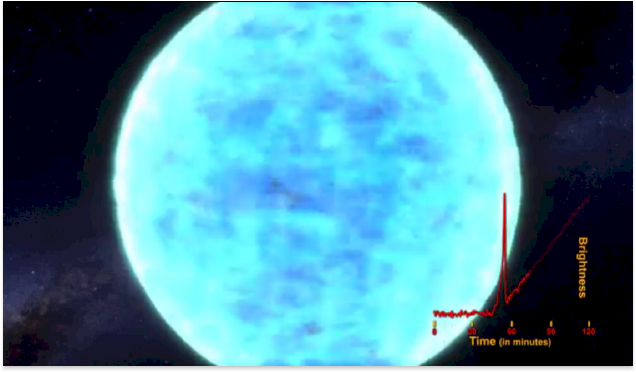|
|
|
|
|

|

|
| |
 |
Caught For The First Time: The Early Flash Of An Exploding Star |
|
|
| |
 |
|
| |

|
|
|
Credits: Credit: NASA Ames,
STScI/G. Bacon
|
| |

|
|
| |
|
 |
The brilliant flash of an exploding star’s shockwave—what astronomers call the “shock breakout”—has been captured for the first time in the optical wavelength or visible light by NASA's planet-hunter, the Kepler space telescope.
Supernovae like these — known as Type II — begin when the internal furnace of a star runs out of nuclear fuel causing its core to collapse as gravity takes over.
Two of these massive stars, called red supergiants, exploded while in Kepler’s view. The first behemoth, KSN 2011a, is nearly 300 times the size of our sun and a mere 700 million light years from Earth. The second, KSN 2011d, is roughly 500 times the size of our sun and around 1.2 billion light years away.
“To put their size into perspective, Earth's orbit about our sun would fit comfortably within these colossal stars,” said
Garnavich.
|
|
 |
|
|
|
|
 |
| The brilliant flash of an exploding star’s shockwave—what astronomers call the “shock breakout” -- is illustrated in this video animation. The cartoon video begins with a view of a red supergiant star that is 500 hundred times bigger and 20,000 brighter than our sun. When the star’s internal furnace can no longer sustain nuclear fusion its core collapses under the force of gravity. A shockwave from the implosion rushes outward through the star’s layers. The shockwave initially breaks through the star’s visible surface as a series of finger-like plasma jets. Only 20 minute later the full fury of the shockwave reaches the surface and the doomed star blasts apart as a supernova explosion. This animation is based on photometric observations made by NASA’s Kepler space telescope. By closely monitoring the star KSN 2011d, located 1.2 billion light-years away, Kepler caught the onset of the early flash and subsequent explosion. |

|
|
| |
|
|
 |
|
|

|
|
|
 |
 |
|
|
|
|
|
|

